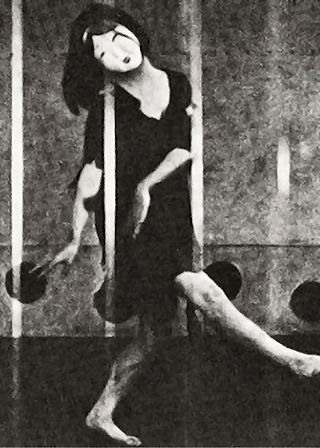 |
| Setsuko Hara and Shuji Sano in Here's to the Young Lady |
Yasuko Ikeda: Setsuko Hara
Sato: Takeshi Sakamoto
Goro: Keiji Sada
Yasuko's Mother: Chieko Higashiyama
Yasuko's Sister: Masami Morikawa
Yasuko's Brother-in-law: Junji Masuda
Yasuko's Father: Yasushi Nagata
Yasuko's Grandmother: Fusako Fujima
Yasuko's Grandfather: Sugisaku Aoyama
Bar Owner: Sachiko Murase
Director: Keisuke Kinoshita
Screenplay: Keisuke Kinoshita
Cinematography: Hiroshi Kusuda
Art direction: Motoji Kojima
Film editing: Yoshi Sugihara, Shizuko Osawa
Music: Chuji Kinoshita
Stop me if you've seen this one: A middle-aged working-class single man meets a pretty young woman from the upper classes and.... Okay, right. It's a romantic cliché, one that's so irresistible that Samuel Goldwyn once ordered a screenplay to be written on the basis of a title alone, The Cowboy and the Lady (H.C. Potter, 1938), and it's the inspiration for the teaming of Spencer Tracy and Katherine Hepburn. But what sets Keisuke Kinoshita's Here's to the Young Lady apart is its country and time of origin: postwar Japan. In part the film is a manifestation of the occupying forces' desire to bring about a more egalitarian Japan, one in which a system of caste and class would be broken down, but it's also a reflection of economic reality in a recovering country whose male population had been decimated by the war. So Keizo Ishizu, a 34-year-old man who owns a thriving auto repair business and has dreams of getting into manufacturing, is introduced by his friend Sato to Yasuko Ikeda, from a cultured and educated family, as a potential wife. Ishizu is smitten instantly by the lovely but very shy young woman, but he also has doubts that she would ever be interested in him -- and he is sort of a schlub, whose chief recreation is drinking at his favorite bar. But then Ishizu visits Yasuko at her home and meets her family, learning that they are on the brink of financial disaster. Kinoshita starts with mostly long shots of the living room of the Ikeda home, but then switches to some shots from Ishizu's point of view that reveal the threadbare upholstery and well-worn furnishings. It turns out that Yasuko's father is in prison because after the war he was tricked into joining a company that was on the shady side. When its fraudulent practices were exposed, he honorably took the blame, even though it's suggested that he was ignorant of them. Moreover, a loan is about to come due, one that was taken out to help the family -- which includes Yasuko's mother, grandparents, sister and brother-in-law -- to survive. Ishizu has every reason to flee from this entanglement, but he's so taken with Yasuko that he agrees to court her for a while to see if their marriage would work out. She suggests that they go to the ballet, where he winds up in tears -- partly because he realizes that he can never be a match for her in culture. He takes her to a boxing match, where she winces at the violence but nevertheless winds up cheering for one of the fighters. And so on as obstacles to their marriage rise. We know how it will end, but Kinoshita makes that ending almost plausible, especially with the help of a talented cast that features the always magnificent Setsuko Hara. One blot on the film is the overbearing and sometimes inappropriate use of Chuji Kinoshita's repetitive score, augmented by the overuse of Chopin's Fantaisie-Impromptu in C# minor, the one spoiled for many of us by its use as the melody for the popular song "I'm Always Chasing Rainbows."









